The Films of Martin Scorsese
by Dan heaton
This is the second in a series of essays covering a wide variety of directors and stretching across different genres and countries. The primary goal is to delve into the films of the great minds of cinema and discover some lesser-known works. The films discussed will range from classics that almost everyone knows to smaller works that have disappeared onto video shelves over the years. The one common factor is that I will have seen none of the movies before conducting this study. Hopefully, that element will maintain a freshness to each piece that dissipates with preconceived notions. I will usually try to cover different time periods within the director's career for comparison, but it will vary with each one chosen.
Introduction
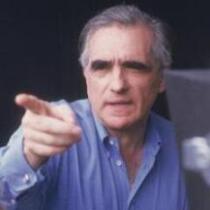 Martin Scorsese seriously considered entering the
priesthood before deciding to utilize his passion for
making films. Scorsese directed the gritty exploiter
Boxcar Bertha in 1972 for producer Roger
Corman. Next, he created the renowned small-time
gangster picture Mean Streets (1973),
which provided the foundations for his unconventional
style. This film featured Robert De Niro and Harvey
Keitel, two actors who collaborated with Scorsese on
some of his most prominent works. They reunited for
Taxi Driver (1976), which covered the
trials of disturbed Vietnam veteran Travis Bickle.
Scorsese received tremendous acclaim for Raging
Bull (1980), the biography of middleweight
fighter Jake LaMotta. Respected U.S. critics Gene
Siskel and Roger Ebert later selected it as the best
film of the decade.
Martin Scorsese seriously considered entering the
priesthood before deciding to utilize his passion for
making films. Scorsese directed the gritty exploiter
Boxcar Bertha in 1972 for producer Roger
Corman. Next, he created the renowned small-time
gangster picture Mean Streets (1973),
which provided the foundations for his unconventional
style. This film featured Robert De Niro and Harvey
Keitel, two actors who collaborated with Scorsese on
some of his most prominent works. They reunited for
Taxi Driver (1976), which covered the
trials of disturbed Vietnam veteran Travis Bickle.
Scorsese received tremendous acclaim for Raging
Bull (1980), the biography of middleweight
fighter Jake LaMotta. Respected U.S. critics Gene
Siskel and Roger Ebert later selected it as the best
film of the decade.
Scorsese outraged some religious groups by attempting to portray a human son of God in The Last Temptation of Christ (1988) before returning to more familiar territory with the Mafia in Goodfellas (1990) and Casino (1995). Casual filmgoers generally associate him with violent, disturbing pictures about gangsters and lowlifes, but Scorsese's body of work reflects more variant subjects. Divergent entries include a surprisingly faithful adaptation of Edith Wharton's The Age of Innocence (1993) and Kundun (1997) - a touching, picturesque biography of the Dalai Lama. His newest film is Gangs of New York, which stars Leonardo Dicaprio and Daniel Day Lewis. It opened in December and has received significant critical accolades.
Films
Mean Streets (1973)
Starring Robert De Niro, Harvey Keitel, David Proval, Amy Robinson, Richard Romanus, Cesare Danova, and Victor Argo. Written by Martin Scorsese and Mardik Martin. Directed by Martin Scorsese
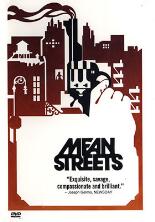 Martin Scorsese achieved his first major dose of
critical acclaim with Mean Streets - a gritty,
personal drama about small-time gangsters in New York.
Harvey Keitel stars as Charlie, a well-liked fellow
who tries to do the right thing, but often falls short
in a difficult environment. The bane of his existence
is Johnny Boy (Robert Deniro) - a wild and crazy guy
who cares very little for anyone else. The normal
rules of the community mean little to him, and
responsibilities like paying back debts rarely enter
his mind. Charlie spends much of the story covering
for Johnny and trying to save him from violent
trouble. The current problem stems from a huge debt
owed to well-dressed loan shark Tony (David Proval),
who may eventually need to use excessive force to
prove a point. Meanwhile, Charlie wants to buy a
restaurant and grasp a better life, but any mistake
could eliminate this chance. The idea of sin obsesses
him, and he feels that God will eventually punish him
for his sins. Charlie tries to do the right thing with
his secret girlfriend Teresa (Amy Robinson) and Johnny
Boy, but complications always foil his plans.
Martin Scorsese achieved his first major dose of
critical acclaim with Mean Streets - a gritty,
personal drama about small-time gangsters in New York.
Harvey Keitel stars as Charlie, a well-liked fellow
who tries to do the right thing, but often falls short
in a difficult environment. The bane of his existence
is Johnny Boy (Robert Deniro) - a wild and crazy guy
who cares very little for anyone else. The normal
rules of the community mean little to him, and
responsibilities like paying back debts rarely enter
his mind. Charlie spends much of the story covering
for Johnny and trying to save him from violent
trouble. The current problem stems from a huge debt
owed to well-dressed loan shark Tony (David Proval),
who may eventually need to use excessive force to
prove a point. Meanwhile, Charlie wants to buy a
restaurant and grasp a better life, but any mistake
could eliminate this chance. The idea of sin obsesses
him, and he feels that God will eventually punish him
for his sins. Charlie tries to do the right thing with
his secret girlfriend Teresa (Amy Robinson) and Johnny
Boy, but complications always foil his plans.
This troubling world has little in common with the stylish life of the mobsters in Goodfellas. The atmosphere is dark and dirty, with transactions taking place in rough pool halls and bleak apartments. The characters and setting of this film exude tremendous realism and do not feel like artificial creations. Scorsese's inspiration sprung from his own childhood in a similar type of neighborhood, and his connection with the events is easily apparent. The action doesn't move as fluidly as his best work, but it still offers signs of a master learning his craft. One lengthy shot with Charlie entering a club recalls Scorsese's best work. Keitel and DeNiro both give remarkable performances and reveal unknown talents that the world will soon discover. Mean Streets is an engaging story that will surprise film lovers raised on classics like Raging Bull and Taxi Driver.
The Color of Money (1986)
Starring Paul Newman, Tom Cruise, Mary Elizabeth Mastrontonio, Helen Shaver, John Turturro, and Bill Cobbs. Written by Richard Price, based on the novel by Walter Tevis. Directed by Martin Scorsese
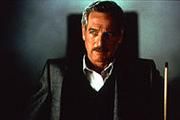 Twenty-five years after The Hustler, Fast Eddie
Felson (Paul Newman) now avoids the big-money game of
pool and sells liquor to neighborhood bars. However,
everything changes when he sights young Vincent (Tom
Cruise), a natural player with all the tools needed to
become a big-time hustler. Eddie takes the arrogant
young man on the road and tries to mentor him about
the basics of scamming opponents. Along for the ride
is Vincent's girlfriend Carmen (Mary Elizabeth
Mastrontonio), a tougher girl who has obviously seen
the darker side of life. They venture through all
types of dirty halls and eventually arrive at the big
tournament in Atlantic City. Even given the
considerable acting talent, this story feels too
generic to really grab the attention. I found Eddie
and Vincent's conflicts mildly interesting, but they
lack the emotional connections that normally exist in
Scorsese's films.
Twenty-five years after The Hustler, Fast Eddie
Felson (Paul Newman) now avoids the big-money game of
pool and sells liquor to neighborhood bars. However,
everything changes when he sights young Vincent (Tom
Cruise), a natural player with all the tools needed to
become a big-time hustler. Eddie takes the arrogant
young man on the road and tries to mentor him about
the basics of scamming opponents. Along for the ride
is Vincent's girlfriend Carmen (Mary Elizabeth
Mastrontonio), a tougher girl who has obviously seen
the darker side of life. They venture through all
types of dirty halls and eventually arrive at the big
tournament in Atlantic City. Even given the
considerable acting talent, this story feels too
generic to really grab the attention. I found Eddie
and Vincent's conflicts mildly interesting, but they
lack the emotional connections that normally exist in
Scorsese's films.
Even many film lovers are surprised to learn that Martin Scorsese actually directed this middle-of-the road picture. Tom Cruise keeps smiling throughout the film and has a few nice scenes, but this is not one of his better performances. Newman's persona still electrifies the screen, but I wish his character had more compelling activities here. The actor does have one especially touching scene after he's brutally hustled by a young Forrest Whitaker, but it just is not enough. Scorsese's usual visual mastery only appears a few times during the pool matches, and most of the shots lack his sharp originality. He does nicely capture the atmosphere of the smoky pool hall, but the key scenes are only mediocre. The soundtrack consists of far too many generic '80s titles that date the story considerably. Newman's touching performance makes the tale your time, but it lacks that distinctive Scorsese style that would distinguish it from similar genre pictures.
The Last Temptation of Christ (1988)
Starring Willem Defoe, Harvey Keitel, Barbara Hershey, Victor Argo, Verna Bloom and Harry Dean Stanton. Written by Paul Schrader, based on the novel by Nikas Kazantzakis. Directed by Martin Scorsese
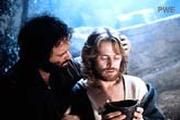 Upon the initial theatrical release of The Last
Temptation of Christ, fiery objections from a
vocal religious minority generated tremendous
controversy over the more human portrayal of Jesus
Christ. The powerful Blockbuster Video chain still
refuses to place this extremely misunderstood film on
its rental shelves. The central objections stem from
the lengthy climax where Satan creates a hallucination
to tempt Jesus (Willem Defoe) into avoiding his
ultimate fate. The devil presents the allure of an
ordinary life with Mary Magdalene (Barbara Hershey) as
his wife and a large family. During this vision, Jesus
makes love to her in a sweet scene that avoids much
sensationalism. However, the rampant criticism focused
on the fact that Jesus was having sex, not on the
context of the scene. These moments eventually
showcase Christ's final victory over evil and
acceptance of his deadly fate. Taken directly from
Nikas Kazantzakis' novel, this conclusion reveals a
temptation that could appeal to almost everyone, which
makes his final rejection more powerful.
Upon the initial theatrical release of The Last
Temptation of Christ, fiery objections from a
vocal religious minority generated tremendous
controversy over the more human portrayal of Jesus
Christ. The powerful Blockbuster Video chain still
refuses to place this extremely misunderstood film on
its rental shelves. The central objections stem from
the lengthy climax where Satan creates a hallucination
to tempt Jesus (Willem Defoe) into avoiding his
ultimate fate. The devil presents the allure of an
ordinary life with Mary Magdalene (Barbara Hershey) as
his wife and a large family. During this vision, Jesus
makes love to her in a sweet scene that avoids much
sensationalism. However, the rampant criticism focused
on the fact that Jesus was having sex, not on the
context of the scene. These moments eventually
showcase Christ's final victory over evil and
acceptance of his deadly fate. Taken directly from
Nikas Kazantzakis' novel, this conclusion reveals a
temptation that could appeal to almost everyone, which
makes his final rejection more powerful.
Martin Scorsese is obviously fascinated by the story of Christ, and he did not intend to demystify or tear down his image. Instead, this tale focuses on the idea that he is both God and man, which would lead to the difficulties faced by all humans. However, this version of Jesus is much different than the usual idea of a quiet guy preaching about loving your neighbor. While that material exists here, it resonates differently because of Defoe's slightly crazed portrayal. He storms through the Jewish temple with a fanaticism that veers more towards insanity than stoic contentment. Many of the usual moments occur, including the resurrection of Lazarus and the entrance into Jerusalem, but everything emits a rough, energetic force often missing from other versions. This story is not for everyone, but it should strike a chord with insightful viewers willing to observe a divergent look at the familiar story.
Gangs of New York (2002)
Starring Leonardo DiCaprio, Daniel Day-Lewis, Cameron Diaz, Jim Broadbent, John C. Reilly, Henry Thomas, Brendan Gleeson, and Liam Neeson. Written by Jay Cocks. Directed by Martin Scorsese
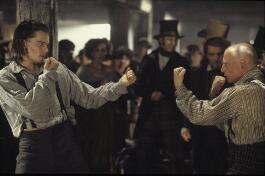 After several years of tremendous anticipation,
Gangs of New York finally reached the screen
this past December. Scorsese had wanted to portray
the chaotic streets of 19th-century New York since the
early days of his directing career. The ultimate
result is a gripping tale of love, revenge, and blood
rushing through the dirty alleys of the Five Points
neighborhood. Priest Vallon (Neeson) leads his gang
of Irishmen against the vicious "natives" of William
Cutting (Lewis), also known as "Bill the Butcher."
Following a nasty battle, Vallon is murdered, but his
son Amsterdam (DiCaprio) lives on to seek revenge when
he reaches adulthood. While gaining Cutting's
confidence, he bides his time for the precise moment
to seek retribution. Situated in the middle is
attractive thief Jenny Everdeane (Diaz), who develops
a mostly unconvincing connection with Amsterdam. The
events culminate in the Draft Riots of 1863, which
showcase Union soldiers murdering innocent citizens in
the streets of New York City.
After several years of tremendous anticipation,
Gangs of New York finally reached the screen
this past December. Scorsese had wanted to portray
the chaotic streets of 19th-century New York since the
early days of his directing career. The ultimate
result is a gripping tale of love, revenge, and blood
rushing through the dirty alleys of the Five Points
neighborhood. Priest Vallon (Neeson) leads his gang
of Irishmen against the vicious "natives" of William
Cutting (Lewis), also known as "Bill the Butcher."
Following a nasty battle, Vallon is murdered, but his
son Amsterdam (DiCaprio) lives on to seek revenge when
he reaches adulthood. While gaining Cutting's
confidence, he bides his time for the precise moment
to seek retribution. Situated in the middle is
attractive thief Jenny Everdeane (Diaz), who develops
a mostly unconvincing connection with Amsterdam. The
events culminate in the Draft Riots of 1863, which
showcase Union soldiers murdering innocent citizens in
the streets of New York City.
Much of this story's allure stems from its entirely believable atmosphere of 19th-century life in the city. Citizens skulk in uncomfortable stone homes and watch in horror as looters steal their goods from under their noses. Ethnic brawls occur constantly and reveal a larger tension beneath the minor skirmishes. Scorsese's major achievement is enveloping us into this frenetic environment and accurately conveying the class and race distinctions. He also draws a powerhouse performance from Daniel Day-Lewis, who once again moves into remarkably unfamiliar territory. This fictional tale does re-write history in its depiction of the Draft Riots, which did cause an uproar but did not reach such a large scale. Historians do not correlate the depiction of military ships firing onto the mainland. While not a complete success, the memorable images of the growing metropolis and Lewis' remarkable work raise the merely adequate tale to a grander level.
Conclusion
Martin Scorsese has crafted a wonderfully diverse and intelligent body of work during his lengthy film career. It would be nearly impossible to summarize his wide array of stories during an essay of this short length. No matter which genre he tackles, Scorsese's pictures rarely delve into mundane territory. The films often feature energetic soundtracks and premier editing that help to generate an exhilarating viewing environment. Genre pictures like Cape Fear and The Color of Money may not possess the ambitions of his best work, but they remain interesting in some form. Even his average pictures rank among the better releases of their particular year. Most lists of recent classics of American cinema will usually contain several or more Scorese pictures. His directorial style will remain influential for numerous future generations.
Copyright (c) 2005 erasing clouds |
|